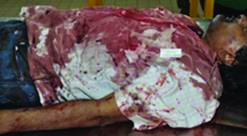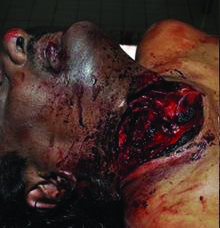The forensic pathologists have a challenging task during the ascertainment of the manner of death in cut throat injuries when presented with no proper history or witnesses. We report a rare homicide, where a person was killed by the father of his gay partner. A 51-year-old married man was found dead in his car on the driving seat at a road. There were blood stains on the dash board and windscreen. No weapon had been recovered. At autopsy, a deep, oblique, long incised injury was found on the front of the neck. There were no hesitant or defense injuries. The cause of death was cut throat. The findings were compatible with a homicidal cut throat by a right handed person from behind after head being restrained firmly. Findings were compatible with the history provided by the suspect.
Case Report
A 51-year-old married man was found dead in his car on the driving seat at a busy roadway around 1.30 p.m. He had been a right handed person.
No weapon had been recovered from the vehicle or at the scene. On examination, there was lot of blood and blood stains in the vehicle including the dashboard and the windscreen.
The initial post-mortem investigation revealed no suspect. At the autopsy, the clothes showed vertical distribution of blood [Table/Fig-1]. A deep, obliquely placed, long incised neck injury was found on the front side of the neck. The left end of the injury started below the ear at upper third of the neck and deepened gradually with severance of the left carotid artery. The right sided end of the injury was at the mid third of the neck with a tail abrasion [Table/Fig-2].
Clothes showed vetical distribtion of blood stains and the left end of the cut throat started just below the ear.

Cut throat from right side.

There were no other injuries including hesitant cuts or defense injuries. Lungs showed aspiration of blood. Deceased’s blood was negative for alcohol. There was no evidence such as frothy blood or air emboli in right ventricle to suggest air embolism. Postmortem X-ray of the chest for the detection of air in the venous system and heart was not done due to technical constraints. Cause of death was cut throat.
Later, the suspect was produced, and he was the father of the deceased’s gay partner. The suspect and his son had got into the deceased’s car to request him to terminate this relationship, because the son did not consent for an arranged marriage. The suspect had been in the rear seat right behind the deceased and the son had been the front seat passenger. When the deceased disagreed to terminate the relationship, father of the gay partner had cut the throat of the deceased using a knife and both had escaped. The suspect was a right handed person.
Discussion
Cut throats can be homicidal, suicidal or accidental [1]. Homicidal cut-throats are a well-recognized method of killing while suicidal cut throats are less commonly reported and accidental cut throats are rare [2]. The forensic pathologists have a challenging and important task when ascertaining the manner of death when cut throats are presented with no proper history or witnesses [3]. It was highlighted in the OJ Simpson case too, where the body of OJ Simpson’s ex-wife, Nicole was found dead with her throat cut [4].
Emotionally driven murders are committed by mothers in neonaticides [5], intimate partners of hetero or homosexual relationships, etc. Further, killing of a gay partner by the other partner has been reported in literature due to different reasons such as attempting to terminate the relationship, initiate a relationship with another partner, etc. However, the case under discussion is a rare homicidal cut throat where the perpetrator was the father of the gay partner.
Accidental cut throats are exceptionally rare. They are usually seen only when a victim goes through a sheet of glass or is struck in the neck by a sharp-edged missile or flying piece of glass [6]. In this case, there was no evidence of the vehicle being met with an accident to sustain such a cut throat injury.
The suicidal cut throat wound is similar to the homicidal cut throat from behind. The wound usually begins higher on the neck on the side opposite to where it terminates [6]. Since the deceased was a right handed person, the suicide cut throat should typically start from upper third of the left side of the neck and be ended at a point lower than the origin on the right side as was found in this case.
Suicidal cut throats are usually, but not always, accompanied by hesitation marks [6]. In this case, no such hesitation injuries were found. Further, a fatal suicidal cut throat may be accompanied by cadaveric spasm with the knife found firmly clenched in the victim’s hand. According to the investigation findings, even a weapon was not found at the scene. Further, there were no self-inflicted injuries or scars such as multiple, parallel and superficial injuries in accessible sites according to dexterity of the deceased [7]. When the history, autopsy findings and scene findings are considered the suicidal cut throat could be safely excluded.
Homicidal cut throats can be produced in two different ways; depending on whether they are produced from the back or the front [4]. Of those two methods, cutting a person’s throat from behind is the most common. The head is pulled back, and the knife is then drawn across it. The knife is drawn across the neck, from left to right by a right-handed assailant and from right to left by a left-handed individual [6]. The wound inflicted deepening at the beginning and then tails off at the opposite side of the neck [8]. The gradually deepening left end should be the beginning [8] of the cut throat and was reconfirmed by the tail abrasion found at the right end. Therefore, the direction of this cut throat should be left to right.
The homicidal cut throat injuries inflicted from behind are usually longer. They usually starts below the ear, runs obliquely downward and medially, then straight across the midline of the neck, and ends on the opposite side of the neck, lower than its point of origination [6]. Therefore, in this case, the neck incision was compatible with a cut throat from behind by a right handed person.
Contrary to that, the homicidal cut throats inflicted from the front tend to be short and angled. Horizontal wounds inflicted from the front are the least common [6]. Further, instead of the neck being cut with one long, continuous motion, these wounds are inflicted by several swipes or slashes [6] and such short injuries were not found in this case. Therefore, homicidal cut throat inflicted from the front side can be safely excluded.
It was noticeable that the deep cut throat found in this case was a single incision without surrounding injuries. Multiple, parallel, superficial cuts found above and below the deep fatal cut in homicides suggest that the deceased attempted to get away, his head was not sufficiently immobilized by restrain and he was intoxicated or tortured [8]. In this case, the alcohol level was negative and there were no such superficial cuts. Presence of single deep cut suggested that the deceased’s head would have been restrained firmly.
Presence of blood stains on the windscreen and dash board of the vehicle further confirmed that it was a deep cut severing the arteries resulting blood spray front of the victim. The vertical distribution of the blood stains re-confirmed the seated position of the deceased in the vehicle at the time of the infliction of injuries.
There was no evidence of mutilation or emotionally driven injuries. Emotionally motivated killings occur in jealousy, intense hatred and in sexual overtones. Further, they show evidence of overkill or rapid stabs and are indicated by multiple, parallel, uniformly deep stabs, grouped in one area of the body with or without mutilation [8]. The killing method used in homicides may reflect the motivation of the offender and qualities of the victim-offender relationship [9], however, such emotionally driven injuries were not found in this case. Absence of such injuries could be important to assess the reliability of the suspect’s claim for the murder rather than his son, the gay partner of the deceased.
At autopsy, there was no evidence of air embolism such as frothy blood or air emboli in right ventricle. Mechanisms of death in this case were blood loss and aspiration of blood following the cut throat.
The length of time it takes to die following an incised wound of the neck depends on several factors. They include whether the venous or arterial systems are severed and whether there is air embolism [6]. In some instances, victims with single carotid artery cut have moved for about 10 minutes [10].
Conclusion
The homicidal pathologists have to assess all the possibilities voicing their adjudgment. As, in this case, the possibilities of the homicidal cut throat injuries inflicted from behind were analysed. With the presence of evidence of spurting and massive haemorrhage, a prolong survival was highly unlikely and the deceased could have survived most probably seconds or minutes.
[1]. Yadav A, Raheel MS, Kumar RL, Sharma SK, Kanwar H, Cut-throat wounds: Suicidal and homicidal-two case reports and review of literatureMedicine, Science and Law 2015 2015:0025802415591200[Epub ahead of print] [Google Scholar]
[2]. Knobler P, Petrocelli D, Triumph of Justice: The Final Judgment on the Simpson Saga 1998 New Yorkcrown publishers [Google Scholar]
[3]. McKee A, Egan V, A case series of twenty one maternal filicides in the UKChild Abuse and Neglect 2013 37(10):753-61. [Google Scholar]
[4]. Di Maio DJ, Di Maio VJM, Forensic pathology 2001 2nd edFloridaCRC Press LLC [Google Scholar]
[5]. Spitz WU, Sharp force injury. In: Spitz WUSpitz and Fisher’s medicolegal investigation of death 2006 4th edSpringfieldCharles C Thomas:532-606. [Google Scholar]
[6]. Mize KD, Shackelford TK, Intimate partner homicide methods in heterosexual, gay, and lesbian relationshipsViolence and Victims 2008 23(1):98-114. [Google Scholar]
[7]. Ozdemir B, Celbis O, Kaya A, Cutthroat injuries and honor killings: review of 15 cases in eastern TurkeyJournal of Forensic and Legal Medicine 2013 20(4):198-203.doi: 10.1016/j.jflm.2012.09.011 [Google Scholar]
[8]. Solarino B, Buschmann CT, Tsokos M, Suicidal cut-throat and stab fatalities: three case reportsRomanian Journal of Legal Medicine 2011 19(3):161-66.DOI: 10.4323/rjlm.2011.161 [Google Scholar]
[9]. Sauvageau A, Trepanier JS, Racette S, Delayed deaths after vascular traumatism: two casesJournal of Clinical Forensic Medicine 2006 13:344-48. [Google Scholar]
[10]. Betz P, Tutsch-Bauer E, Eisenmenger W, "Tentative" injuries in a homicideAmerican Journal of Forensic Medicine and Pathology 1995 16(3):246-48. [Google Scholar]